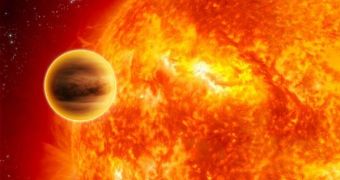WASP-12b has broken all previous records related to how hot, fast or close to a star a planet can be.
As large as 1.8 times the size of Jupiter, the newly-discovered planet, WASP-12b, spins around its star from 1/40 the distance between the Earth and the Sun, completing a full cycle in little over one day, which makes it the planet with the fastest orbit in all recorded history. This challenges the previous beliefs linked to how close a planet can orbit a star from.
The proximity makes it as hot as 2250° Celsius (4082 degrees Fahrenheit) - almost half the temperature on the Sun's surface, and about as hot as some other stars, like red dwarfs. It was discovered by Leslie Hebb and his colleagues from the University of St Andrews in the UK during the Super Wide Angle Search for Planets (SuperWASP) survey. The research used two powerful telescopes (one in the Canary Islands in Spain and the other in South Africa) which looked for planets that would dim their host stars when passing in front of them in relation to the observation point on Earth.
The closeness and hotness factors are calculated based on previous measurements of stars and planets, while their orbits and size are calculated following the transit observations. Regularly, such giant planets have orbit cycles longer than three days and form away from their stars, in the vicinity of which there is not enough dust and gas to evolve from, and migrate towards them rather later during their existence.
According to Hebb, “When the planets form and migrate inward, something is causing them to stop and preferentially stop with a period of three days. I was surprised that the period could be so much shorter”. Also, gas giants are never expected to grow as big as WASP-12b; Sara Seager of MIT explains, “The planet radius is suspiciously large. While observation is leading theory, it's uncomfortable to have a planet with a radius that cannot be accommodated by theory”.
The only explanation found by scientists was that the closeness to its star and the fact that it may be composed of metals like its own sun causes the planet to inflate. The next hottest star, HD 149026b, has a deep-black surface which yields a temperature of 2040° Celsius (3704 degrees Fahrenheit).

 14 DAY TRIAL //
14 DAY TRIAL //